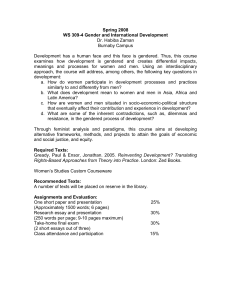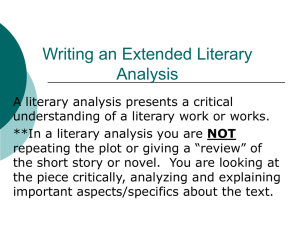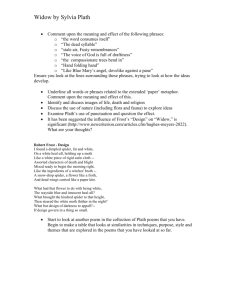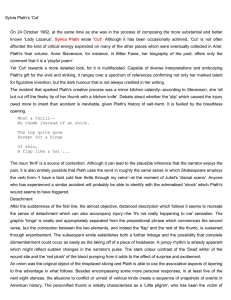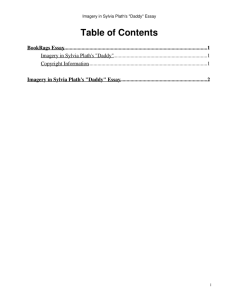Tips for Writing a Senior Seminar Thesis Statement
advertisement
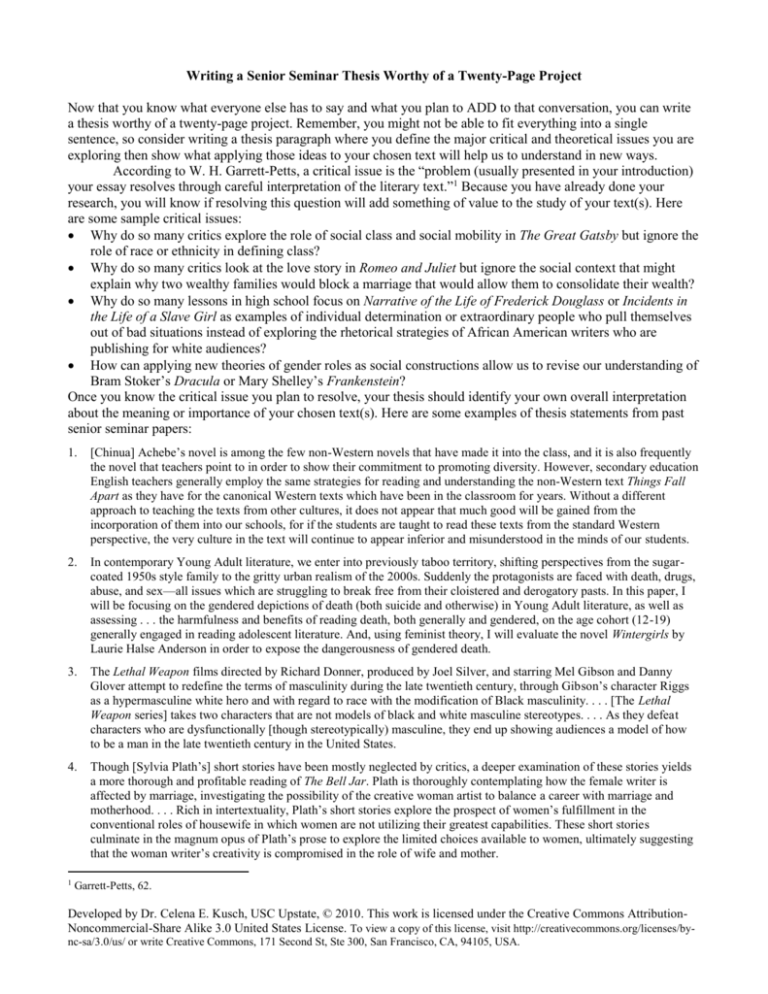
Writing a Senior Seminar Thesis Worthy of a Twenty-Page Project Now that you know what everyone else has to say and what you plan to ADD to that conversation, you can write a thesis worthy of a twenty-page project. Remember, you might not be able to fit everything into a single sentence, so consider writing a thesis paragraph where you define the major critical and theoretical issues you are exploring then show what applying those ideas to your chosen text will help us to understand in new ways. According to W. H. Garrett-Petts, a critical issue is the “problem (usually presented in your introduction) your essay resolves through careful interpretation of the literary text.”1 Because you have already done your research, you will know if resolving this question will add something of value to the study of your text(s). Here are some sample critical issues: Why do so many critics explore the role of social class and social mobility in The Great Gatsby but ignore the role of race or ethnicity in defining class? Why do so many critics look at the love story in Romeo and Juliet but ignore the social context that might explain why two wealthy families would block a marriage that would allow them to consolidate their wealth? Why do so many lessons in high school focus on Narrative of the Life of Frederick Douglass or Incidents in the Life of a Slave Girl as examples of individual determination or extraordinary people who pull themselves out of bad situations instead of exploring the rhetorical strategies of African American writers who are publishing for white audiences? How can applying new theories of gender roles as social constructions allow us to revise our understanding of Bram Stoker’s Dracula or Mary Shelley’s Frankenstein? Once you know the critical issue you plan to resolve, your thesis should identify your own overall interpretation about the meaning or importance of your chosen text(s). Here are some examples of thesis statements from past senior seminar papers: 1. [Chinua] Achebe’s novel is among the few non-Western novels that have made it into the class, and it is also frequently the novel that teachers point to in order to show their commitment to promoting diversity. However, secondary education English teachers generally employ the same strategies for reading and understanding the non-Western text Things Fall Apart as they have for the canonical Western texts which have been in the classroom for years. Without a different approach to teaching the texts from other cultures, it does not appear that much good will be gained from the incorporation of them into our schools, for if the students are taught to read these texts from the standard Western perspective, the very culture in the text will continue to appear inferior and misunderstood in the minds of our students. 2. In contemporary Young Adult literature, we enter into previously taboo territory, shifting perspectives from the sugarcoated 1950s style family to the gritty urban realism of the 2000s. Suddenly the protagonists are faced with death, drugs, abuse, and sex—all issues which are struggling to break free from their cloistered and derogatory pasts. In this paper, I will be focusing on the gendered depictions of death (both suicide and otherwise) in Young Adult literature, as well as assessing . . . the harmfulness and benefits of reading death, both generally and gendered, on the age cohort (12-19) generally engaged in reading adolescent literature. And, using feminist theory, I will evaluate the novel Wintergirls by Laurie Halse Anderson in order to expose the dangerousness of gendered death. 3. The Lethal Weapon films directed by Richard Donner, produced by Joel Silver, and starring Mel Gibson and Danny Glover attempt to redefine the terms of masculinity during the late twentieth century, through Gibson’s character Riggs as a hypermasculine white hero and with regard to race with the modification of Black masculinity. . . . [The Lethal Weapon series] takes two characters that are not models of black and white masculine stereotypes. . . . As they defeat characters who are dysfunctionally [though stereotypically) masculine, they end up showing audiences a model of how to be a man in the late twentieth century in the United States. 4. Though [Sylvia Plath’s] short stories have been mostly neglected by critics, a deeper examination of these stories yields a more thorough and profitable reading of The Bell Jar. Plath is thoroughly contemplating how the female writer is affected by marriage, investigating the possibility of the creative woman artist to balance a career with marriage and motherhood. . . . Rich in intertextuality, Plath’s short stories explore the prospect of women’s fulfillment in the conventional roles of housewife in which women are not utilizing their greatest capabilities. These short stories culminate in the magnum opus of Plath’s prose to explore the limited choices available to women, ultimately suggesting that the woman writer’s creativity is compromised in the role of wife and mother. 1 Garrett-Petts, 62. Developed by Dr. Celena E. Kusch, USC Upstate, © 2010. This work is licensed under the Creative Commons AttributionNoncommercial-Share Alike 3.0 United States License. To view a copy of this license, visit http://creativecommons.org/licenses/bync-sa/3.0/us/ or write Creative Commons, 171 Second St, Ste 300, San Francisco, CA, 94105, USA.
